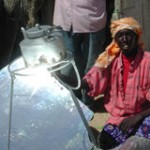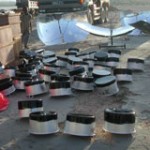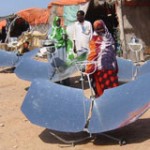Sun Fire Cooking
Sun Fire Cooking is a project that created a certain kind of solar cooker to be sold in Somalian villages.
The project is especially focused on African regions of Somalia where deforestation and desertification are evident problems, but sunshine is rich, both to support villages and possibly also refugee camps.
Implementation has started in Somalia, both on a commercial and on a charitable base after the impact of the Tsunami.
By protecting scarce vegetation, the traditional agricultural and pastoral income source and traditional nomadic herding is supported. The common source of fuel for cooking is charcoal. Additionally, people spend an amount of their limited income on charcoal.
The butterfly solar cooker consists of two large flaps of parabolic mirrors, made of cast iron coated with reflective aluminum tape. The mirrors focus the heat on a stove on the centre, ideally the pot is painted black to help attract heat. The total shape of the two mirrors is a long rectangle, which allows access to the cooking pan.
The aluminum coating can easily be repaired. An easy screw mechanism allows adjustment of the tilt of the mirrors, while wheels enable movement of the stove that is 50-80 kg of weight.
The size of the cooker produces an enormous heat output, at least comparable with or even stronger than traditional charcoal stoves. Users even report reduced cooking times. The stove can boil one litre of water in seven minutes.
The powerful performance and the futuristic design, make the cookers popular and successful within the population. The idea of owning a product that is modern and technologically advanced makes the product more desirable for people than only focusing on its ecological and economic benefits.
Reports from users comment on men becoming interested in cooking because of interest in the solar cooker.
The lifetime of a cooker is estimated to be about twenty years. The first cooker was distributed in 1998 is still in use without failure.
pict
The solar cookers are not meant as the sole heating source of the household but to be combined with other sources for the time of day. In the morning time people still use the traditional charcoal stove. Users report a charcoal consumption drop from 100kg to 25kg per month, thus saving 75%, about 20$, per month.
The cookers are not distributed freely but to be purchased at an affordable price of 200$. In ten months the investment will have repaid itself by the money saved on charcoal. Sun Fire Cooking encourages potential clients to take up a small credit which is repaid in less than a year by a monthly rate of the same amount of money usually spent for charcoal.
The money and time saved from purchasing coal can be used for other useful activities, like sending kids to school.
Cookers are distributed, set up, explained and tested in cooperation with the villagers, their participation avoids mistakes in use and enhances acceptance.
The business concept is a winwinwin-model, combining people, planet, and profit: replacing charcoal protects the local and the global environment, its economic benefits support people’s livelyhoods, and the product is sold on a commercial base, awarding the project with profit. The company also advertises to Somalians supporting their families from abroad to invest in a solar cooker providing them with a regularly saved amount of money for a long time. As a reaction to the devastation of the Tsunami 2004 the particularly destroyed village of Bander Beyla was provided with 950 solar cookers, one per household, with support of the UN and the NGO Horn Relief.
pict








